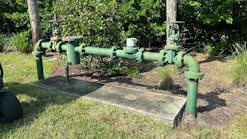Garza, a field maintenance technician II, stars in a video Clean Water Services produced as part of the public education component of its National Pollutant Discharge Elimination System (NPDES) permit. As his sweeper rolls along neighborhood streets, Garza demonstrates and explains his street sweeping routine in the video.
“Street sweeping is the first line of defense,” he tells viewers. “It helps pick up pollutants off of the road surface.”
Loosely associated with Washington County, Clean Water Services (CWS) is responsible for stormwater services and management in all of the unincorporated parts of the three counties. It holds the NPDES permit for all of Washington County. The stormwater utility provides service for about a half million residents. Workers are employed directly by CWS.
Steve Keenon, surface facility maintenance supervisor for CWS, says the organization is required to use regenerative air–not mechanical–street sweepers. CWS relies on Tymco’s Model 435.
“We order it with the sound-reduction option to keep the noise down in the neighborhoods,” says Keenon. “We have four street sweepers on the roads at all times.”
The annual budget for sweeping, debris processing and screening, hauling, and leaf pickup is about $600,000. With about 1,000 miles of curbed and guttered streets to clean, CWS has to focus on saving both time and energy costs.
“We put a drop box out in the area so operators don’t have to drive full sweepers back to empty them. The Tymco is the only smaller unit that will drop into a 20-yard drop box,” explains Keenon.
The drop boxes are in place for only one day, so complaints from residents are rare. Occasionally someone who works at night and is home sleeping in the daytime asks if CWS can move the box farther away so he won’t be awakened by the sounds of dumping. “We’ve been lucky. We’ve had so few complaints,” says Keenon.
CWS’s service area is urban and suburban with high density of land usage encouraged. That practice means that property lot sizes are smaller and landscaping is closer to the streets. The smaller model sweeper is ideal, Keenon says, because it’s a little lower, so dealing with trees close to the streets isn’t a problem. “The larger machines have a tough time getting through our neighborhoods,” he notes.
Catch basins are cleaned a minimum of once a year, using Vactor trucks. The streets are cleaned once a month. Although the area receives heavy annual rainfall, individual rainstorms are not usually heavy enough to stop street cleaning operations.
With all of the trees, “our biggest time of year is our leaf season,” says Keenon. “We work extra hours during this time to keep caught up.” However, appearance is not the most important consideration. “I think street sweeping is very important for the environment,” says Keenon. “I’m more concerned with the environment, with keeping as many pollutants as possible out of the water supply, than I am with how the streets look.”
Picking up fine particles by street sweeping is essential in this part of the country because of the clay soil present. “Phosphorous, nitrogen, and other pollutants bind easily with our clay soil,” explains Keenon.
Lest anyone question the value of street sweeping, Keenon paraphrases an old adage: “For every dollar spent cleaning the streets, you’d spend 10 dollars cleaning the debris out of pipes.”
CNG in Austin
Vidal Maldonado is a division manager with Austin Resource Recovery in Austin, TX. The city uses the Schwarze A7000 and Tymco Model 600 street sweepers, all owned by the city and operated by city employees.
Austin’s 21 sweepers are replaced on a seven-year replacement schedule. On average, three sweepers need to be replaced each year. The budget for the sweepers’ purchase and maintenance is separate from the city’s stormwater budget.
Austin’s street cleaning program “targets the cleaning of curbed city streets in all areas within the city limits for removal of trash, litter, and dirt that has collected in the streets and gutters for health, safety, aesthetic, and water-quality reasons,” explains Maldonado.
The sweeping schedule for residential streets is about six times each year. “Boulevards are swept 12 times per year and the central business district is swept daily,” says Maldonado.
Street sweeping doesn’t seem to bother Austin residents. “We sweep around cars,” says Maldonado. “We post our schedules on the Austin Resource Recovery website to minimize problems with parked cars.”
Maldonado says the sweepers do a good job of picking up both leaves and smaller particles. While his agency hasn’t collected any data to show the operation’s effectiveness, “we get very few complaints citywide on street cleanliness.”
The agency has purchased several compressed natural gas (CNG)-powered sweepers and expects to add more in the next few years. Future changes might include adding new sweeper models and possibly changing the frequency that streets are swept. “In addition, Austin Resource Recovery is analyzing routing methodology, sweeping techniques, and equipment types to improve efficiency,” says Maldonado.
Cooperation in Lake County, OH
Lake County, OH, lies along the shore of Lake Erie. Fourteen of its 20 Phase II-regulated communities are co-permittees on Lake County’s NPDES permit. They are members of the Lake County Stormwater Management Department (LCSMD).
The Lake County board of commissioners and the Lake County engineer created LCSMD in 2003. This stormwater utility agency also partners with the county’s health district, its soil and water conservation district, and Chagrin River Watershed Partners to manage stormwater for the member communities.
“It’s a great partnership of all those involved and has been a real asset to the citizens of Lake County as we strive to improve the water quality of stormwater runoff,” says Timothy Miller, director of the LCSMD.
LCSMD is probably one of the first stormwater utilities in Ohio. Its past joint projects include much-needed drainage improvements in member communities and a challenging 2,300-linear-foot stream restoration in one of the urban watersheds.
The 14 member communities of LCSMD get their streets swept by a 2003 Elgin Eagle street sweeper and a 2010 Elgin Megawind, which is both a street sweeper and a catch basin cleaner. Curbed streets are cleaned at least once a year.
It can take as long as two months to finish the first round of sweeping in the spring, which starts when most of the bad weather is over. The second sweeper was purchased so that the sweeping cycle would become shorter. A second sweep is planned for fall, but may not happen on all streets if winter comes early.
On the first spring sweep, Miller says, “We’ll find that a lot of the debris may be sand or cinders left over from the winter. Trash is ever-present at all times of the year, and the fall will find leaves in the gutter of the curb.”
Street sweeping in Lake County “is a joint effort between the county employees and the employees of the member communities,” says Miller. “The county employees operate the sweeper, while the municipality will provide an employee and a dump truck for hauling the material to a solid waste facility.”
He adds, “This partnership allows the sweeper to maintain a longer presence within a municipality for sweeping purposes.”
The communities served by LCSMD don’t have much on-street parking, so cars don’t interfere with the sweeping operation. “There has not been any negative feedback from the public with our program,” says Miller.
He sees street sweeping as an effective best management practice (BMP) for removing pollutants from stormwater runoff, used in conjunction with other components of the Phase II program.
“By keeping our roadways and catch basins clear of debris and pollutants, we are reducing the amount of pollutants that enter into the storm drainage system and our local waterways, including Lake Erie,” he says, noting also the effectiveness of “keeping our maintenance facilities in good condition.”
LCSMD reserves one day a week for routine maintenance of the sweepers so that the machines always run as efficiently as possible. The stormwater utility strives for energy efficiency in other ways, too.
“The street sweeping routes are coordinated to minimize over the road travel from one location to another. The cooperation of our member community to haul the material to a solid waste facility while the street sweeper remains on location to continue allows the sweeper to maintain a longer presence on the road,” says Miller.
Efficiency in Minneapolis
Energy efficiency is also a part of the street sweeping operation in Minneapolis, MN, where Lisa Cerney serves as the city’s director of surface water and sewers. “Staff works to ensure proper maintenance of the fleet plus the use of B20 [biodiesel] fuel in the units that burn diesel fuel,” says Cerney. “All units are using refined oils to be energy efficient. In addition, newer sweepers and vacuum trucks are coming with the new emission standards for exhaust.”
Cerney says that her staff members “continue to work at utilizing the right equipment at the right time and in the right locations, and are adding tracking technology. The city of Minneapolis also has an anti-idling policy, which does not allow a unit to idle for more than three minutes.”
The right equipment isn’t only of one type or from one manufacturer. “The city of Minneapolis uses a variety of equipment for street cleaning and catch basin cleaning, ranging from mechanical units to regenerative air sweepers and vacuum trucks,” says Cerney.
Minneapolis has 1,100 miles of centerline streets and 400 alleys to keep clean. It’s not surprising that the sweeping program is divided into several categories, which vary in frequency and work practices, Cerney explains.
The entire city is swept in the spring and again in the fall. “During the summer and winter, as conditions allow, key commercial areas are swept frequently, depending upon the use of the area,” she says.
Beyond the business districts, she says, “parkways and residential streets near water bodies are swept on regular cycle to minimize sediment loading. Remaining residential and local roadways are swept a couple times throughout the year outside of the comprehensive [spring and fall] sweeps.” Employees of the Public Works Department pick up approximately 20,000 tons of material annually. “There is a need to pick up all sizes of particles, which is a driving factor in having a variety of equipment,” says Cerney.
The annual budget for fleet maintenance is approximately $1 million. Most equipment is on a 10-year life cycle. Most street sweeping activities are performed by city employees using city-owned equipment, Cerney says.
Getting citizens to appreciate the street sweeping operations has not proven to be a problem. The temporary parking restrictions don’t draw complaints from residents. “Typically, only the spring and fall comprehensive sweeps are performed with aggressive enforcement of parking restrictions,” says Cerney. “The public is generally happy to have their streets cleaned and understand the stormwater quality benefits as well as neighborhood cleanliness perspectives.”
Cerney sees street sweeping as an essential BMP component of the city’s Phase I NPDES permit. It promotes clean water “by removing leaf litter, sediment, and debris from streets and gutters before the materials and the pollutants attached to them can be washed into storm drain inlets.”
A New Program in Seattle
Shelly Basketfield serves as manager of Seattle’s Street Sweeping for Water Quality Program (SSWQP). Started in February 2011, this program is a specialized street sweeping operation separate from the regular sweeping of all city streets. SSWQP’s initial focus is sweeping curbed arterials and industrial roadways at night.
“Not only does this tactic target higher-pollutant-loading streets, it also reduces the impact on residents,” says Basketfield. “We currently do not request residents to move their cars.”
Seattle Public Utilities (SPU) sets the program direction, provides water-quality expertise, and provides funding for the portions of routes that drain to the municipal separate storm sewer system, which discharges directly to receiving waters, says Basketfield.
SPU’s partner for the program is the Seattle Department of Transportation (SDOT), which Basketfield says, “provides operational expertise, street sweeping services, and funding for the portion of the routes that drain to the combined sewer system.”
SSWQP is based in part on results from a pilot study conducted by SPU, which suggested that “street sweeping with a water-quality objective had the potential to be a cost-effective basic treatment stormwater BMP, where “˜basic treatment’ is defined as removing total suspended sediment,” says Basketfield. She notes that results for the first year of the program have confirmed that street sweeping is one of the most cost-effective BMPs available in the city.
For the special SSWQP, Seattle uses four regenerative air sweepers, Schwarze A8000 models, that do regular sweeping for about 40 weeks of the year. The rest of the year they are used for fall leaf pickup or are available for emergency response. Night sweepers also remove snow and ice.
The program currently consists of 22 routes, of which 16 are swept every other week and the remaining six are swept weekly, says Basketfield. The two daytime operators each work one eight-hour shift; each one covers one route each day. Most of the sweeping is done at night, when three drivers each work four 10-hour shifts. The night shift runs all seven nights. Two routes are covered on Mondays, Tuesdays, and Wednesdays; three routes on Thursdays; and one route on Fridays, Saturdays, and Sundays.
Basketfield says that the night shift operators all volunteered to work those shifts. “They and their shift supervisor, Kelvin Green, have been instrumental in making the program a success. Their feedback and willingness to adapt to the program needs has resulted in excellent service and significant pollutant-reduction benefits,” she adds.
Workers are employees of the DOT and use sweepers owned by the city of Seattle. Services provided by the DOT for the portion of the routes draining to the MS4 cost $495,000.
Basketfield says that RouteSmart, a GIS-based software application, has not only reduced traveling time for sweepers but also has improved fuel efficiency. “SDOT has a successful program in place to reduce greenhouse gases by reducing equipment idling time,” she adds.
Future plans for the SSWQP include purchase of four new Schwarze A9000 regenerative air sweepers, due to arrive soon. The new sweepers will improve equipment availability and capacity, Basketfield says. “We will implement new routes that have been optimized using RouteSmart and likely begin a voluntary parking compliance program on the arterials.” Long-term plans include studying “parking compliance strategies, expansion into residential neighborhoods, and sweeping on noncurbed roadways.
Other Cities and Future Developments
Springfield, MI, uses a 2011 Tymco Model 600 for street sweeping, catch basin cleaning, and minor hydroexcavating, says Tom Matson, director of public works. Matson’s Public Works Department crews have a $40,000 annual budget to sweep about 35 miles of street, cleaning each street three to four times annually. Michigan winters don’t allow sweeping.
“Spring sweeping usually contains more sand and fines,” says Matson. “In the fall it seems like we are just sucking leaves. During the summer it seems like it’s just dirt and debris.”
In Algonquin Township, IL, highway commissioner Robert Miller and his workers rely on an Elgin Crosswind for street sweeping and catch basin cleaning. “Maintenance is the key to longevity of sweepers,” explains Miller. “We bring them in an hour early to clean the sweepers.”
Algonquin Township is a rectangle 6 miles by 8 miles, with about 120 lane miles of roads to clean. The sweepers run on a three-day cycle, cleaning each street about once a month–more often if a storm leaves debris.
Miller says that the Crosswind “picks up everything that’s on the street. We used to be able to dump debris anywhere. Now we’re doing all our product onsite. We dry it and at the end of the season the fill that’s left can be trucked anywhere it’s needed.”
This “creative use of material” is possible because of the Remu screening bucket, he notes. It strains out garbage and bottles and doesn’t crush plastic bottles. Miller has been pleased with this purchase. “We’re still finding uses for it. It pulverizes dirt and in winter we can use it to take the lumps out of road salt,” he says.
Street sweeping experiences with porous pavement varied among the people interviewed; representatives of most departments represented in this article reported that they had not dealt with it.
Springfield does not have any porous pavement. However, its crews have done some sweeping of porous pavement in neighboring Battle Creek, which runs only mechanical sweepers.
“We have porous pavement at our facility, porous concrete in the employees’ parking lot,” says Keenon of CWS. “It’s not a problem if it’s put down right. It depends on what kind of silt load you put on it.”
As for future changes and developments in street sweeping, LCSMD’s Miller predicts that “street sweeping will include more GPS tracking to improve efficiencies, and more computerization of the machines to keep them working in an efficient and effective manner.” He also expects to see “further studies and analysis on the debris that is picked up to quantify types and amounts of pollutant removal to gauge the effectiveness of street sweeping.”
Cerney says Minneapolis is in the process of implementing a pilot project “to install GPS combined with technology to regularly collect data related to weight of debris collected as the equipment is operating.” The project’s goal is to have real-time data to use in stormwater modeling and increased accuracy in reporting. “If successful, we believe these tools will more accurately help us respond to MS4 reporting and total maximum daily load waste load allocations tracking,” she says.
In cities large and small street sweeping may be overlooked by the public, or even considered a nuisance if they have to move their cars. But in the cities profiled above it’s clear that stormwater officials know its value in keeping water clean.






